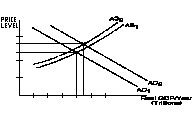|
Home
Syllabus
Lecture Outlines
Assignments
Review
Textbook
Website
|
The best way to study is to do the assignments:
But let me page through the book and see if I can give
you some hints. NOTE that these hints will not cover
everything that is on the exam.
CHAPTER 5
- have a general idea of the main sources of of revenue
and the main expenditures categories for each level of
government.
- be able to calculate marginal tax rate and average
tax rate.
- be able to calculate the amount of tax that you have
to pay if you are given the marginal tax rates (See Key
Question #15 p. 90).
|
(Key Question # 15) Suppose in Fiscalville
there is no tax on the first $10,000 of income,
but a 20 percent tax on earnings between
$10,000-20,000 and a 30 percent tax on income
between $20,000 and $30,000. Any income above
$30,000 is taxed at 40 percent. If your income
is $50,000, how much in taxes will you pay?
Determine your marginal and average tax rates.
Is it a progressive tax? Explain.
Total tax = $13,000; marginal tax rate = 40%
average tax rate = 26%. This is a progressive
tax; the average tax rate rises as income goes
up.
|
CHAPTER 7
- - definition of GDP
- - what is included and what is not included
- - what is "double counting" or "multiple
counting"?
- - calculate GDP using the expenditures approach
(question #8 a, p. 129)
|
a. Using the above data, determine GDP by
both the expenditure and the income approaches.
Then determine NDP.
(a) GDP = $388, NDP = $361
|
- - calculate and define NDP
- - calculate and define "In" (net investment)
- - calculate Xn (net exports)
- - use the Income Approach to calculate NI (national
income)
- - define NI (national income), PI (personal income),
and DI (disposable income)
- - define and calculate real GDP (be able to fill in
the blanks of Table 7.5 on p. 123)
- - know what a price index is
- - what is the CPI
- - know whether the "shortcomings of GDP"
UNDERESTIMATE or OVERESTIMATE real domestic output
CHAPTER 8
- - know the phases of the business cycle
- - know causes of the business cycle
- - what is unemployment? who is included and who is
not?
- - what is full employment? Why is 4% unemployment
considered to be full employment?
- - know the types of UE
- - GDP gap
- - define inflation
- - be able to calculate the inflation rate (see Key
question #11, p. 151)
|
This year's rate of inflation is 10% or
[(121 - 110)/110] x 100.
Dividing 70 by the annual percentage rate of
increase of any variable (for instance, the rate
of inflation or population growth) will give the
approximate number of years for doubling of the
variable.
a. 35 years - 70/2
b. 14 years - 70/5
c. 7 years - 70?10
|
- - demand-pull IN and cost-push inflation
CHAPTER 11
- - this is the most important chapter so know it
well
- - the extra credit essay question will ask you to
analyze a news article using the AS/AD model. Be sure to
discuss which DETERMINATE changed, and USE GRAPHS to
explain what happened to UE, IN, and EG. Several of these
are done in our online lecture.
- - DO THE STUDY GUIDE AND THE ONLINE REVIEW
QUESTIONS
CHAPTER 17
- - includes some pages from chapter 8
- - know the difference between the two types of EG
discussed in class
- (1) increasing the potential GDP and
- (2) achieving the potential GDP.
- Illustrate both using the PPC and the AS/AD
graphs.
- Know which "ingredients of Growth" (supply factors,
demand factors, efficiency factors) causes which type of
growth.
- - Accounting for growth (pp. 312-316). Understand
table 17.1 on page 313
- - what is the "New Economy"/
- - Is growth Desirable?
CHAPTER 22 W
- - know the characteristics of the less developed
economies ("Measures of Development" in our class
lectures)
- - know the growing income gap between the rich and
the poor countries (p. 22W-3)
- - understand how rapid population growth affects
economic development in the less developed countries
- - the vicious circle
- - role of government
- - role of advanced nations - understand the "Trade
vs. Aid" issue. Especially see "Expanding trade" on p.
22W-12
- - see the connection between "DVC policies promoting
growth" (pp. 22W15-17) and the Structural Adjustment
Policies that we discussed early in the semester
|
